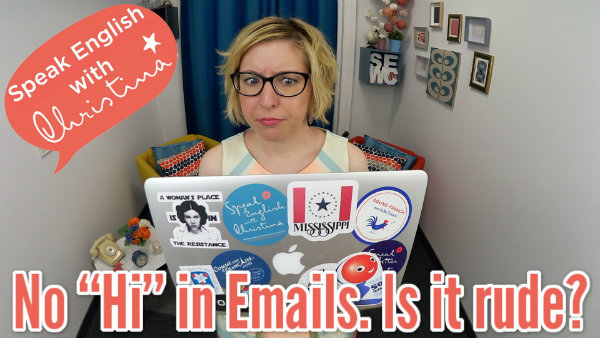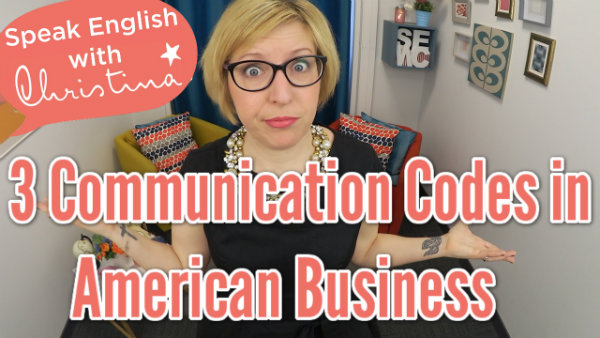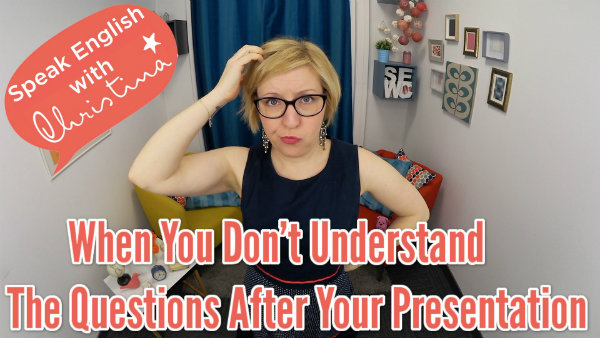
Hi there! I’m your English coach Christina, welcome to Speak English with Christina, where you’ll learn American culture and business know-how to become confident in English.
Today I want to help you with your emails.
Commenter Michael had a great question: “I always start my email to my franchisor by “hope everything’s ok” or stuff like that. And today, he answered with no “hi” or anything… Just answering right away my question. Should I do the same? Should I stop being polite and just go to the point next time?”
Great question, Michael, let’s look at this one!
A short story:
Let’s say that Anna just received an email from Paul, an American colleague.
The message starts with “Do you have last year’s sales report?”. It’s direct: there’s no greetings like “Hi Anna,” “Hello” or even “Dear Anna”… She feels confused: is Paul being rude? Is he upset? Aggressive?
Then Anna gets worried: is Paul writing normally, and she is the one lacking etiquette when she starts all her emails with “Hello” and “How are you” ? Maybe adding such a personal introduction is not OK in American culture?
Anna notices she’s confused. She knows it’s probably a minor misstep anyway, so it would be weird if she bring it up to Paul, yet she’d like to know more.
Well, don’t worry, we’ll figure out what to do!
What’s the deal with email introductions?
Let me reassure you: it’s not a cultural difference. Or at least, not a national cultural difference.
Most Americans will write an introduction on most emails they send from their computers, just like they would on a letter.
However, there are two main reasons we would skip the greetings. The first one is when it’s the best we can do: when we don’t really have time to respond properly, but we still want to send the information. So we’ll write the minimum, and “Hi Anna, how are you?” gets cut.
The second reason is close to the first, but much more common. Emails used to be treated as letters, but now they tend to be seen almost as instant messaging. We type it on our phone, and we treat a series of emails as a flowing conversation. You wouldn’t say “Hello” to your friend every time you start a new sentence in messenger, would you?
The way we view email conversations is more a personal than a cultural difference, so they’ll always be some time of adaptation with each person you meet. As you get more familiar with the other person, you might even drop the introduction, so it can be a sign of friendliness!
Anyway, the worst case scenario is probably skipping the introduction when emailing someone for the first time. Don’t do it. If someone does it to you, it’s not nice, but they probably don’t want to be rude. It’s just a little lack of etiquette at worse; they forgot that social cues get lost in writing.
A Quick Tip in Using Email Greetings
There’s no hard rule about it, but I want to give you some quick guidelines you can use.
If you’re emailing someone for the first time that day, a quick greeting won’t hurt.
If it’s a conversation during a day, like if you’re collaborating with a colleague on an ongoing project, you can cut straight to the chase.
But if you haven’t emailed the other person for a day or two, go ahead and put a quick “Hi Anna,” (or whatever their first name is). Honestly, it takes 3 seconds.
And if it’s been a while, maybe a week or so, sure, a little greeting like “I hope you’re doing well” or “I hope you had good weekend” never hurts.

Now, tell me: what other problems did you face when writing your last email in English?
Share them in the comments!
Want to immediately understand 12 everyday expressions that Americans say fast? Get my free pronunciation and comprehension lesson with exercises. Just click here! And of course subscribe to my channel, so you get a new English lesson each week! Thanks for watching Speak English with Christina, and I’ll see you next time!

More good stuff...
Click the image to learn more








Hi Christina !
Thanks for this video : it’s a very good question and it’s a very interesting answer too !
As the beginning of an email is important, I think that the end is also essential.
Could you advise me about the different polite forms American people used ? and in which situations to use them ?
Thank you for your answer.
Best
Cam-Tu
Hi, Christina
Thank you for the information on greetings. However, I normally have a problem with the endings. I’m never sure about what is too formal or too casual to say.
Hi Christina.
I love your videos, I much remains to be learned.
I’m always browsing on your page.
Thank you for your attitude dynamics.
Even though English is my first language, I always find your posts so interesting Christina!
your blog help a lot for a beginner like me.. excellent information is given on this blog.
This is such a good article, and one which I am experiencing right now with a business associate. We have never emailed each other till recently. He initiated our brief email exchange with no greeting. I always replied to him with a greeting of “Hi (First Name),”. Never once has he greeted me in return. I suppose since he initiated the exchange, I should have followed his lead and omitted the greeting in mine. But it feels so cold to me and makes me feel like an idiot for having greeted him 3 times already, and never got a hint of a greeting in return. I feel really slighted when people do this to me. It’s as if I’m not worth being acknowledged because I’m less then human. And the funny thing is, he wants something from me, and not the other way around, but you’d never know that from his obstinate coldness. There’s something eerie and robotic about omitting the greeting in business emails, at least the initial ones. Like I’m an android and shouldn’t feel offended by it. Too late… I already think this guy is an a-hole, which proves I never was an android to begin with.
Thanks for sharing informative information. I do appreciate your video thoughts.
You’re very welcome!
Hi Christina,
I have a question the answer to which I haven’t been able to find so far.
Imagine you have seen a person today and later in the day you are sending him/her an email. Can we say “Hi/Hello, Tom” even though we have already greeted each other in person earlier today? Or is it better to just write his first name “Tom” without saying “hello”?
Could we write “Dear Tom” in case we know this person quite well professionally but we are not friends? Wouldn’t it be too formal?
Which of the three given possibilities is the best, in your opinion?
Thanks a lot in advance!
Best regards,
Maria
Hi Maria,
Great question! If you have already seen Tom, you can say “Hi Tom” or “Hello Tom” (It’s totally fine, even if you saw him already). Or you can say “Hi again,” or “Hello again,”. You don’t need to add his name, but you can. It really does not make a difference, I’d say.
As for “Dear Tom”, I feel that this is too formal for an email in most cases if you already know the person.
On the other hand, just writing “Tom” makes it sound like your email is announcing some bad news, or that Tom did something wrong! If I got an email that just started “Christina,” I would start worrying about what the rest of the email says!”
I hope that helps, but in doubt, you can always just put “Hello Tom,”. It’s a good one-size-fits-all greeting!
Thanks a lot, Christina! That’s very useful!
Hi Christina, If someone I don’t know is sending me an email addressing with my name without Hi, Hello, Dear and I feel it inappropriate. What should I revert to make him realise that I did not liked it.
Great question Afroz, and the first thing I can suggest is the old rule “Do unto others what you would have them do unto you”. In normal language, it means treat people the way you want them to treat you. So you can start by using the other person’s first name when you reply to their emails, and see if they begin to do the same.
However, most people also use just “Hi” or “Hello” to save time, and they may also be worried about misspelling the name of the recipient. So they do not include a name. In fact, this is very common in business, where people want to do things quickly, and may not take time for formalities.
So I may also suggest that you try not to be personally offended by it, as I’m sure that the sender does not have any bad or rude intentions.
I hope that helps you!
You helped me so much as a writer’s conference newbie with the same advice you just wrote. And when I was a college journalism major, our prof told us the same for newspaper writing. Thanks!
Hi Jesika, High five to you! I’m so glad that my advice was useful for you, and that your professor agrees 😉
Hi Christina – I find it incredibly rude and disrespectful when someone in the workplace sends me an email and doesn’t greet me with a “hi” or “hello.” Even worse when they just type my name and start barking out orders and requests at me. It’s like saying “Hey, you! Do this!” Further worse when they don’t know me personally and refuse to use “please” and “thanks.” English is my first language, so I think it’s rudeness and pure laziness to not greet people in emails when you’re asking for things. Those three keystrokes (“H_I”) won’t kill you. I tend to take longer to respond when I’m not greeted professionally and cordially.
Hi Mike, Thanks so much for your input here, and I agree with you that it doesn’t take an eternity to write “Hi Mike” at the top of an email! Personally, I usually write “Hi XXX, I hope you’re having a good week” or some other similar “small talk”, but that may just be me! I also receive emails where it’s just like “I can’t find my password. Can you send it to me?” I agree that I feel a bit of a twinge at these emails, but I also remind myself that many people writing to me are learning English, and they may not master all the nuances of polite language, nor know what would be acceptable or not because their own email culture is a bit different from mine. So I do try to give people the benefit of the doubt, and perhaps also use it as a teaching opportunity (but that’s because I’m teaching them English. I wouldn’t do that if I were responding to a fellow native speaker who just has poor email etiquette!)
Hi Christina,
Thanks for the information you give on American email etiquette.
I have a question if you don’t mind? I’m currently studying an online course and have American professors. One of them regularly starts with ‘Hi xxx’ when commenting on student’s work. However, the other one often just writes ‘Ms Rebuffet’ and doesn’t use ‘Hi’ or ‘Dear’ or anything. I appreciate she has to send feedback to a lot of students but it just strikes me as rude and as Mike said above, as if she doesn’t feel the need to be polite because she is in a position of authority and can ‘bark orders’ about what the student should or shouldn’t do in their work.
Would you give your opinion on this as an American?
Many thanks,
Ellie
Hi Ellie,
Thanks so much for your question, and for your own impressions of the situation. If I were in your position, I would say to myself that it’s just a question of personal taste from the teachers. Some teachers like to treat their students as equals, and some teachers prefer to keep a certain distance and maintain their position of authority. It’s not especially rude, just a question of personal preference and personality on the part of the professors.
When I was a student, I had professors like that too. Some were very friendly, enjoyed talking with students outside of lessons, etc. I’m even friends with one of my university professors on Facebook now!
And I also had some professors who were very strict, were not pleasant to work with, and who I felt less comfortable with because they put themselves in a hierarchical position of authority.
When we talk about cultural differences, we can’t say that “For Americans, it’s rude/polite to…” because it’s too generalized. We have to also remember that within national culture, we also find regional culture, local culture, company culture, family culture, personal culture, etc.
So I’d say don’t worry too much about it. Your professor is not being rude. But if I were in your position, I would respond in a tone similar to the one the teacher uses in their emails. Part of learning a language and culture is being able to adapt! 🙂
Hi, This constantly happens to me. Correct salutation seems a thing of the past. I mean It doesn’t take much to, at the very least, begin with a simple Hi…
It peeves me enough to take my business elsewhere when dealing with mono responses & I bet I’m not alone on that one!
Hi Christina,
I found this vlog when I Googled “when colleagues don’t say hi in an email.” The funny thing is that I am an American! I work in the United States at a private boarding school where manners are ostensibly very important, and the colleague I’m referring to is also an American!! This is so frustrating. It feels very, very rude to me. Saying “Hi” actually takes LESS than three seconds and, in my opinion, should never be forgotten when it’s the first email in a day. Just like you say here in this video. I dread having anything to do with the colleague who doesn’t have the most basic manners this way.
Thanks for making this video!